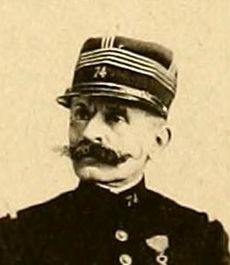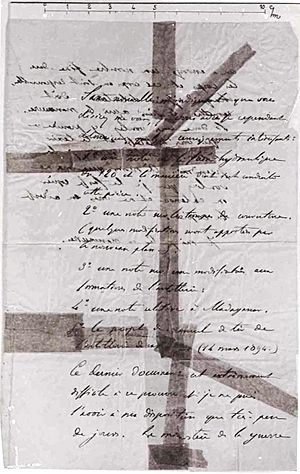Ferdinand Walsin Esterhazy facts for kids
Quick facts for kids
Ferdinand Walsin Esterhazy
|
|
|---|---|
 |
|
| Birth name | Charles Marie Ferdinand Walsin Esterhazy |
| Born | 16 December 1847 Paris, France |
| Died | 21 May 1923 (aged 75) Harpenden, England, UK |
| Allegiance | |
| Service/ |
French Army |
| Years of service | 1870–1898 |
| Rank | Major |
| Unit | French Foreign Legion 74th Line Infantry Regiment |
| Battles/wars | Franco-Prussian War |
Ferdinand Walsin Esterhazy (born December 16, 1847 – died May 21, 1923) was an officer in the French Army. He served from 1870 to 1898. He became well-known as a spy for the German Empire.
Esterhazy was the real person who committed the act of treason for which Alfred Dreyfus was wrongly accused. Captain Dreyfus was found guilty in 1894 during the famous Dreyfus Affair.
After people found and shared evidence against Esterhazy, he had a secret military trial in 1898. He was officially found not guilty. Esterhazy left the military as a major in 1898. He then went to the United Kingdom, where he lived until he died in 1923.
Contents
Biography of Ferdinand Esterhazy
Early Life and Military Service
Ferdinand Walsin-Esterhazy was born in Paris, France. His father was General Ferdinand Walsin-Esterhazy. His father was a division commander in the Crimean War.
Ferdinand became an orphan at nine years old in 1857. He went to school in Paris but could not get into a military academy. In 1869, he joined the Legion of Antibes. This was a group of French volunteers serving Pope Pius IX.
Service in the Franco-Prussian War
In June 1870, Esterhazy joined the French Foreign Legion. This was an unusual way to become an officer. However, the Franco-Prussian War started in July, so his appointment was allowed.
Because many officers were lost in the war, Esterhazy quickly became a lieutenant and then a captain. He fought as an infantry officer in several campaigns. After the war ended, he stayed in the army.
Post-War Career and Financial Issues
Between 1880 and 1882, Esterhazy worked as a German translator. He was in the French military's counter-intelligence section. There, he met Major Henry and Lieutenant Colonel Sandherr. Both would later be important in the Dreyfus Affair.
Esterhazy later worked at the French War Ministry. He spent his money quickly and faced many financial problems. In 1886, he married, but he soon spent his wife's money too.
In 1892, Esterhazy became a garrison-major in Rouen. This was near Paris. He continued to have financial difficulties. He tried to make money through gambling and on the stock market.
He also received help from the Rothschild family in 1894. At the same time, he was friendly with an anti-Jewish newspaper called La Libre Parole. He gave them information.
Esterhazy's military career advanced quickly. He became a lieutenant in 1874, a captain in 1880, and a major in 1892. Despite this, he often complained about his leaders. He even wrote negative comments about the French Army and France.
Role in the Dreyfus Affair
The Dreyfus Affair began in September 1894. A cleaning lady at the German embassy in Paris found a handwritten note. This note, called the bordereau, offered secret military documents to the German Embassy.
The army chose Captain Alfred Dreyfus as the suspected traitor in October 1894. They thought he was guilty mainly because his handwriting matched the note. Also, he was Jewish. Dreyfus was found guilty and publicly stripped of his military rank. He was then sent to a prison colony called Devil's Island.
In 1896, Lieutenant-Colonel Georges Picquart became the new head of the Intelligence Service. He found a letter sent by the German military attaché to Esterhazy. Picquart compared Esterhazy's handwriting to the bordereau. He became sure that Esterhazy was the real culprit.
Picquart tried to convince his superiors, but they did not listen. He was even sent away to Tunisia to silence him. In 1897, Picquart gave his evidence to Dreyfus's lawyers. They began to work to bring Esterhazy to justice.
In 1898, an ex-girlfriend of Esterhazy shared his letters. In these letters, he showed his hatred for France and the army. However, the Army's General Staff still protected Esterhazy. They did not want to question Dreyfus's conviction.
Esterhazy asked for a secret trial by the French Military Justice. On January 10-11, 1898, he was found not guilty. This decision caused anti-Jewish riots in Paris.
On January 13, 1898, Émile Zola published his famous article, J'Accuse…!. In it, he accused the French government of being anti-Jewish. He especially criticized the trial and jailing of Dreyfus.
Later Life and Flight to Britain
Esterhazy was quietly given a military pension and the rank of major. On September 1, 1898, he shaved off his mustache and fled France. He went to England for safety.
Rachel Beer, an editor for English newspapers, knew Esterhazy was in London. She interviewed him twice. He confessed to her, saying, "I wrote the bordereau." She published his confession in September 1898. She also wrote an article accusing the French military of anti-Jewish bias. She called for a new trial for Dreyfus.
From Harpenden, England, Esterhazy continued to write for anti-Jewish newspapers. He did this until his death in 1923. He is buried in St Nicholas' churchyard, Harpenden. He is buried under the name Jean de Voilemont. His headstone has this false name and a false birthdate.
The Double Agent Idea
Some historians, like Jean Doise, have suggested a different idea. They believe Esterhazy might have been a French double agent. This means he pretended to be a traitor to give false information to the German Army.
According to this idea, Esterhazy's bitterness and lack of patriotism would have helped him seem like a real traitor. He was also fluent in German.
In 1893, he supposedly began working for Maximilian von Schwartzkoppen. Schwartzkoppen was the German military attaché in Paris. Esterhazy reportedly received money from him. In return, Esterhazy gave him information, or misinformation, about artillery.
The information Esterhazy provided was not very valuable. The German military attaché, Alessandro Panizzardi, even doubted Esterhazy's skills as an officer.
The famous bordereau document was found in a wastebasket at the German Embassy. This document was used to convict Dreyfus. It mentioned a new French howitzer and details about French field artillery.
However, the French Army had already decided not to use that howitzer. They were developing a new, revolutionary 75mm field gun. The idea is that the bordereau was designed to prevent Germany from finding out about the new French 75mm gun.
Despite this idea, there are reports that Esterhazy admitted he had "indeed been a spy for Germany."
See also
 In Spanish: Ferdinand Walsin Esterhazy para niños
In Spanish: Ferdinand Walsin Esterhazy para niños




